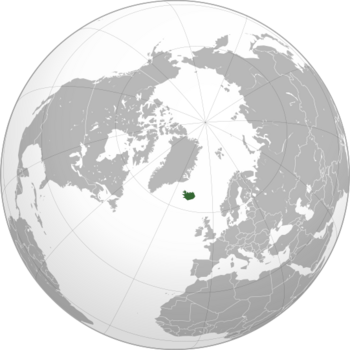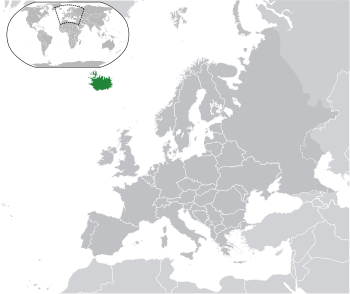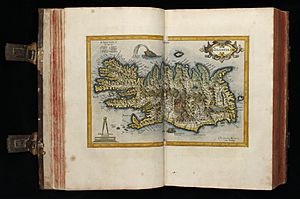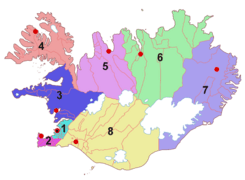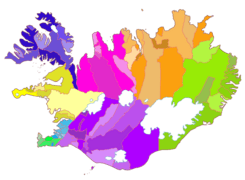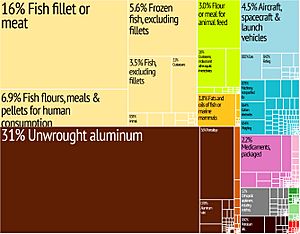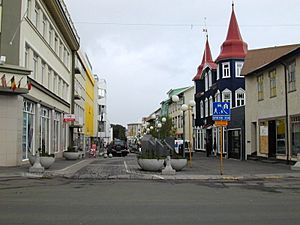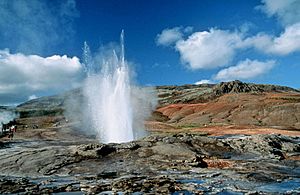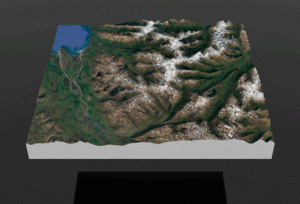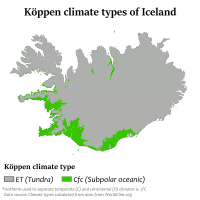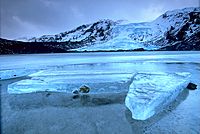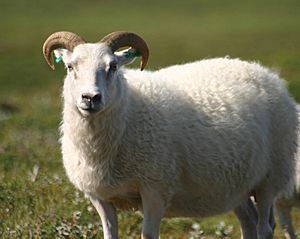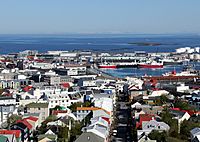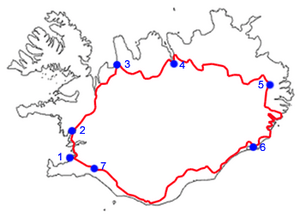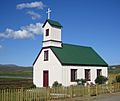Iceland facts for kids
Quick facts for kids
Iceland
Ísland (Icelandic)
|
|
|---|---|
|
Anthem: Lofsöngur
"Hymn" |
|
|
Location of Iceland (dark green)
|
|
| Capital and largest city
|
Reykjavík 64°08′N 21°56′W / 64.133°N 21.933°W |
| Official language | Icelandic |
| Ethnic groups
(2021)
|
|
| Religion
(2022)
|
|
| Demonym(s) |
|
| Government | Unitary parliamentary republic |
| Halla Tómasdóttir | |
| Kristrún Frostadóttir | |
| Birgir Ármannsson | |
| Legislature | Althing |
| Formation | |
|
• Settlement
|
9th century |
|
• Commonwealth
|
930–1262 |
|
• Union with Norway
|
1262–1397 |
| 1397–1523 | |
| 1523–1814 | |
| 14 January 1814 | |
|
• Constitution and limited home rule
|
5 January 1874 |
|
• Extended home rule
|
1 February 1904 |
|
• Sovereignty and personal union with Denmark
|
1 December 1918 |
|
• Republic
|
17 June 1944 |
| Area | |
|
• Total
|
103,125 km2 (39,817 sq mi) (106th) |
|
• Water (%)
|
2.07 (as of 2015) |
| Population | |
|
• 2024 census
|
399,189 (172nd) |
|
• Density
|
3.87/km2 (10.0/sq mi) (242nd) |
| GDP (PPP) | 2023 estimate |
|
• Total
|
|
|
• Per capita
|
|
| GDP (nominal) | 2023 estimate |
|
• Total
|
|
|
• Per capita
|
|
| Gini (2018) | ▼ 23.2 low |
| HDI (2022) | very high · 3rd |
| Currency | Icelandic króna (ISK) |
| Time zone | GMT/WET |
| Date format | dd.mm.yyyy |
| Driving side | right |
| Calling code | +354 |
| ISO 3166 code | IS |
| Internet TLD | .is |
Iceland (Icelandic: Ísland) is an island country in the North Atlantic. It sits between Greenland and Norway. Even though it's an island, it's considered part of Europe. Iceland is about 300 kilometres (186 miles) east of Greenland. It is 1000 kilometres (621 miles) west of Norway. About 399,000 people live in Iceland. The country covers an area of 103,125 square kilometres (39,817 square miles).
Contents
Iceland's History: From Vikings to Independence
The first people to live in Iceland were likely Irish monks. They arrived around the year 800.
In the 9th century, Norsemen from Norway came to Iceland. The first Norseman to live there was Flóki Vilgerðarson. He was the one who gave Iceland its name.
Ingólfur Arnarson was the first permanent settler. This chieftain from Norway settled in Southwest Iceland. He founded the city of Reykjavík.
In 930, Icelandic leaders created a constitution. They set up the Althing, which is a type of parliament. It met in a place called Þingvellir. This makes Iceland home to the oldest existing republic.
In 985, Erik the Red was sent away from Iceland. He had killed someone. He sailed west and found Greenland. Eric's son, Leif Ericson, discovered America in the year 1000. He named it Vinland. The stories of Eric, Leif, and other voyages were written in long tales called sagas.
In 1262, Iceland became part of Norway. This lasted for 400 years. In 1662, it became part of Denmark. In the 19th century, many Icelanders wanted to be free from Denmark. In 1918, Iceland gained more control over its own affairs. However, the king of Denmark was still Iceland's king.
When Germany took over Denmark on April 9, 1940, the Althing decided Icelanders should rule themselves. But they did not declare full independence yet. British and later American soldiers occupied Iceland. This was to prevent attacks from the Germans. In 1944, Iceland finally became fully independent.
After World War II, Iceland joined the North Atlantic Treaty Organisation (NATO). However, it did not join the European Union. Between 1958 and 1976, Iceland and the United Kingdom had three disagreements. These were about the rights to catch codfish. They were known as the Cod Wars.
In 1980, Vigdís Finnbogadóttir was elected president of Iceland. She was the first woman ever elected president of a country.
How Iceland is Governed
Iceland is a parliamentary representative democratic republic. This means the people elect representatives to make laws. The president is the head of state. The prime minister of Iceland is the head of government. Iceland has a multi-party system. Members of the Icelandic parliament are chosen by proportional representation. This means seats in parliament are given based on the number of votes each party gets.
Many political parties in Iceland do not want to join the EU. This is mainly because Icelanders worry about losing control over their natural resources. Their fishing industry is especially important to them.
Regions and Local Government
Iceland is divided into 8 regions. It also has 6 constituencies and 74 municipalities (since 2013). The regions are mostly used for collecting statistics. The constituencies are used to elect politicians to the parliament. The municipalities provide services to the people who live there. These services include education, waste management, and public transportation.
Before 2003, constituencies and regions were the same. This changed because a vote in Reykjavik was worth less than one in a rural area. Even though this was fixed, some differences still exist.
Iceland's Economy
Fishing and processing fish are the main economic activities in Iceland. The country has tried to grow other industries, like tourism. But seafood exports still make up almost three-quarters of all goods sent out of the country. They also bring in about half of all foreign money.
Geothermal Energy creates most of Iceland's electricity. This is because the island sits on the Mid-Atlantic Ridge. This area has many hot water reservoirs and geysers. This makes electricity very cheap in Iceland. It has attracted industries that use a lot of energy.
Aluminum smelting is the biggest energy-heavy manufacturing sector. In 2013, Iceland produced over 800,000 metric tons of aluminum. This made it the 10th largest producer in the world.
Geography: Land of Fire and Ice
Iceland has a lot of geological activity. It also gets a lot of rain and snow. This is due to the warm North Atlantic Current. These factors create many unique natural features. They make Iceland different from other islands near the Arctic Circle.
Some of these features include mountains, volcanoes, hot springs, rivers, lakes, waterfalls, glaciers, and geysers. The English word "geyser" actually comes from Geysir. This is a famous geyser on the southern side of the island. Glaciers cover about 11% of Iceland. The largest, Vatnajökull, is up to 1 kilometre (0.6 miles) thick. It is by far the largest glacier in Europe.
Iceland is considered a European country. However, it sits partly in North America. This is because it lies across the Mid-Atlantic Ridge. This ridge is the boundary between the Eurasian and North American tectonic plates. The ridge runs through Reykjavík and the historic Þingvellir area. The movement of these plates causes the many hot springs and geothermal energy in the region.
Volcanoes and Geysers
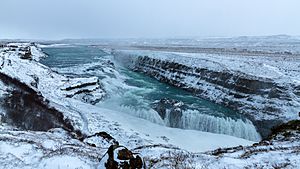
Iceland is very active geologically. It has many volcanoes, including Hekla, Eldgjá, Herðubreið, and Eldfell. The volcanic eruption of Laki in 1783–1784 caused a big problem. It led to a famine that affected many people. The eruption also sent dust and haze over Europe, Asia, and Africa. This affected climates in other areas for months.
Iceland has many geysers. These include Geysir, which gave its name to all geysers. Another famous one is Strokkur, which erupts every 8–10 minutes. Geysir became active again after earthquakes in 2000. However, it has since become quieter and does not erupt often.
Because of the widespread geothermal power and many rivers, Iceland has cheap hot water, heating, and electricity.
On March 21, 2010, a volcano in Eyjafjallajökull erupted. This was its first eruption since 1821. It forced 600 people to leave their homes. More eruptions on April 14 made hundreds more leave. The volcanic ash cloud caused major problems for air travel across Europe.
Another large eruption happened on May 21, 2011. This was the Grímsvötn volcano. It is located under the thick ice of Europe's largest glacier, Vatnajökull. Grímsvötn is one of Iceland's most active volcanoes. This eruption was much stronger than the 2010 one. Ash and lava were thrown 20 kilometres (12 miles) into the air. This created a huge cloud.
The highest point in Iceland is Hvannadalshnúkur. It is 2,110 meters (6,923 feet) high.
Iceland's Climate
Iceland's coast has a subarctic climate. The warm North Atlantic Current keeps temperatures higher than in most places at the same latitude. Places with similar climates include the Aleutian Islands and Alaska Peninsula. Despite being near the Arctic, Iceland's coasts stay ice-free in winter. Ice coming to the coast is rare. The last time was in 1969 on the north coast.
The climate changes across the island. The south coast is generally warmer, wetter, and windier than the north. The Central Highlands are the coldest part. Low-lying inland areas in the north are the driest. Snowfall in winter is more common in the north than the south.
Plants and Trees in Iceland
About three-quarters of Iceland has no plants. Plant life is mostly grassland. This grass is often eaten by farm animals.
When people first settled the island, it had many forests. About 30% of the land was covered in trees. Human settlement greatly changed this isolated ecosystem. The soil is thin and volcanic, and there are few types of plants. Forests were used for firewood and timber for centuries. Deforestation, colder weather during the Little Ice Age, and too much grazing by sheep caused the loss of important topsoil. This led to erosion.
Today, many farms have been left empty. Three-quarters of Iceland's 100,000 square kilometres (38,610 square miles) are affected by soil erosion. About 18,000 square kilometres (6,950 square miles) are so eroded the land is useless. Only a few small birch tree areas remain in protected places. Planting new forests has increased the number of trees. However, it does not compare to the original forests. Some of the new forests include introduced species.
The tallest tree in Iceland is a Sitka spruce. It was planted in 1949 in Kirkjubæjarklaustur. In 2013, it was measured at 25.2 meters (82.7 feet) tall.
Animals of Iceland: Wildlife and Farm Animals
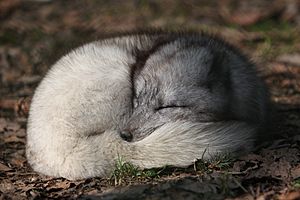
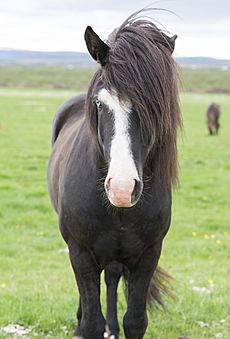
The only native land mammal when humans arrived was the Arctic fox. It came to the island at the end of the ice age by walking over the frozen sea. Sometimes, bats are carried to the island by winds, but they cannot live there permanently. Polar bears sometimes come from Greenland, but they are just visitors. There are no wild populations of polar bears in Iceland. There are also no native or wild reptiles or amphibians on the island.
The farm animals of Iceland include the Icelandic sheep, cattle, chickens, goats, the strong Icelandic horse, and the Icelandic Sheepdog. All these animals are descendants of those brought by early European settlers. Wild mammals include the Arctic fox, mink, mice, rats, rabbits, and reindeer. Marine mammals include the grey seal and harbor seal.
Many types of fish live in the ocean around Iceland. The fishing industry is a huge part of Iceland's economy. It makes up about half of the country's total exports. Birds, especially seabirds, are also an important part of Iceland's animal life. Atlantic puffins, skuas, and black-legged kittiwakes build nests on its sea cliffs.
Commercial whaling happens sometimes, along with scientific whale hunts. Whale watching has become a big part of Iceland's economy since 1997.
About 1,300 types of insects are known in Iceland. This is a small number compared to other countries. Iceland has almost no mosquitoes.
Major Towns and Cities
Reykjavík is the capital city of Iceland. It is also the most important port. Other important towns in Iceland are Akureyri, Kópavogur, Hafnarfjörður, Keflavík, Seyðisfjörður, and Vestmannaeyjar.
Getting Around Iceland
Most people in Iceland own cars. This is because cars are the main way to travel around the country.
Keflavík International Airport (KEF) is the largest airport. It is the main hub for international flights. It serves many international and domestic airlines.
Reykjavík Airport (RKV) is the second largest airport. It is only 1.5 kilometres (0.9 miles) from the capital city center.
Akureyri Airport (AEY) and Egilsstaðir Airport (EGS) are two other domestic airports. They have limited international flights.
Six main ferry services provide regular access to different communities. They also help shorten travel distances.
Iceland does not have any passenger railways.
The People of Iceland
Most people in Iceland are from Scandinavia. They speak Icelandic. The language has not changed much in 1,000 years. Because of this, Icelanders can still read the old sagas about the Vikings easily. Most people in Iceland are Christian. Most of them follow the Lutheran faith.
Icelandic people are often considered to be very happy. Iceland has the highest birth rate in Europe. It also has the highest percentage of women working outside their homes.
Icelandic Language and Names
Iceland's official language is Icelandic. It is a North Germanic language that comes from Old Norse.
English and Danish are required subjects in school. English is widely understood and spoken. Many older people have a basic knowledge of Danish. Polish is mostly spoken by the Polish community. This is the largest minority group in Iceland. Danish is often called skandinavíska (meaning Scandinavian) in Iceland. It is usually understood by Swedes and Norwegians.
How Icelandic Names Work
There are no real surnames in Iceland. Children get their last name from their father's (or sometimes mother's) first name. If it's a boy, "-s+son" is added. If it's a girl, "-s+dóttir" is added.
For example, if a man named Jón Stefánsson has a son named Fjalar. Fjalar's last name will not be Stefánsson like his father's. It will become Fjalar Jónsson.
The same rule applies to women. If Jón Stefánsson's daughter is named Kata, her last name would not be Stefánsson. It would be Jónsdóttir.
In most countries, people call others by their last name. But in Iceland, people use first names. So, when people talk about Halldór Ásgrímsson, they call him Halldór, not Ásgrímsson.
Images for kids
-
Ingólfr Arnarson (modern Icelandic: Ingólfur Arnarson), the first permanent Scandinavian settler
-
British and Icelandic vessels collide in the Atlantic Ocean during the Cod Wars. The Icelandic vessel is shown on the left; the British vessel is on the right.
-
The Nesjavellir Geothermal Power Station services the Capital Region's hot water and electricity needs. Virtually all of Iceland's electricity comes from renewable resources.
-
Reykjavík Junior College (Menntaskólinn í Reykjavík), located in downtown Reykjavík, is the oldest gymnasium in Iceland.
-
Reykjavík, Iceland's largest metropolitan area and the centre of the Capital Region which, with a population of 233,034, makes for 64% of Iceland's population. (numbers from 2020)
-
Björk, the best-known Icelandic musician
-
A typical Þorramatur assortment
-
The Iceland men's national handball team (pictured) won the silver medal at the 2008 Summer Olympics. Handball is considered Iceland's national sport.
See also
 In Spanish: Islandia para niños
In Spanish: Islandia para niños




